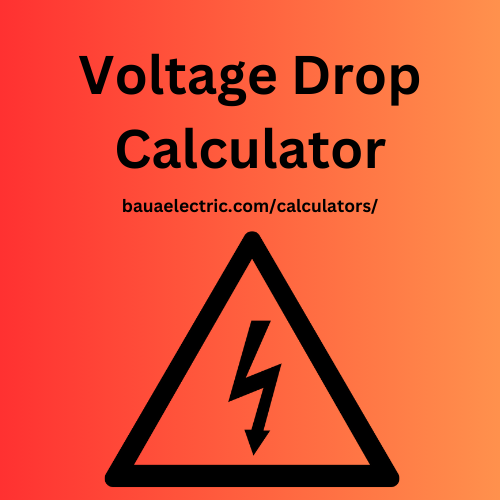Voltage Drop Calculator
Voltage Drop Calculator: Understand and Calculate Your Electrical System’s Efficiency
When designing or troubleshooting an electrical system, one critical factor you need to consider is the voltage drop in the wiring. The Voltage Drop Calculator is a useful tool that helps you calculate how much voltage is lost over the length of a wire due to its resistance. Knowing this information can be the key to preventing inefficiency, power loss, and safety hazards in your electrical circuits.
What is Voltage Drop?
In any electrical system, voltage is the driving force that pushes electrical current through wires. However, as the current flows, some energy is lost due to the resistance of the wire. This loss manifests as a reduction in the voltage reaching the equipment or device at the other end of the wire. This is known as voltage drop.
If the voltage drop is too high, it can affect the performance of electrical equipment, cause overheating, and even lead to safety issues such as fires. Understanding how to calculate and manage voltage drop is essential for both electricians and DIY enthusiasts.
Why is Calculating Voltage Drop Important?
- Ensure Proper Functioning: Excessive voltage drop can cause lights to flicker, appliances to underperform, and equipment to be damaged.
- Safety Concerns: Voltage drop is often associated with overheating wires. Overheated wires are a fire hazard.
- Cost Savings: By minimizing voltage drop, you can reduce energy waste and save on electricity bills.
- Regulatory Compliance: In some cases, local electrical codes specify the allowable voltage drop for specific installations.
How the Voltage Drop Calculator Works
Our Voltage Drop Calculator allows you to quickly determine how much voltage is lost in your electrical wiring system. By inputting a few simple values, the tool computes the voltage drop, helping you assess whether your wiring is appropriate for your electrical load.
Here’s a breakdown of the values you’ll need to enter and what they mean:
1. Length of the Wire (in meters)
The first piece of information you need is the length of the wire. The longer the wire, the more resistance it has, leading to a higher voltage drop. This value should be entered in meters.
2. Current (in amperes)
Next, you’ll enter the current flowing through the wire, measured in amperes. This is the amount of electrical current the wire carries from the power source to the load (such as lights or machinery). More current flowing through the wire means more energy loss, so current is directly related to voltage drop.
3. Voltage (in volts)
The voltage is the power being delivered by the electrical system. This is usually provided by the main power supply or generator and can typically range from 110V to 240V for household appliances, or higher for industrial systems.
4. Resistivity (in ohm-meters)
The resistivity of the wire’s material determines how much resistance the wire offers to the flow of electricity. Different materials have different resistivity values. For example:
- Copper: 1.75 × 10⁻⁸ ohm-meters
- Aluminum: 2.82 × 10⁻⁸ ohm-meters
The resistivity of the material affects how much voltage is lost as the current travels through the wire.
5. Cross-Sectional Area (in square meters)
The cross-sectional area of the wire determines how much current it can carry without excessive heating. Thicker wires have lower resistance and therefore lower voltage drops. This value is usually given in square millimeters (mm²), but it can be converted to square meters for the calculation.
How to Use the Voltage Drop Calculator
- Enter the Wire Length: Input the total length of the wire in meters. If the wire runs through multiple sections, sum up the length of all sections.
- Enter the Current: Input the amount of current, usually specified in amperes, that will flow through the wire.
- Enter the Voltage: Specify the voltage of your electrical system (e.g., 120V or 240V).
- Input the Resistivity: Provide the resistivity of the wire material. You can find the resistivity values for common materials such as copper and aluminum in tables online or in product specifications.
- Input the Cross-Sectional Area: Finally, enter the wire’s cross-sectional area in square meters. You can also use standard wire gauge charts to get the correct area for your wire.
Once you enter all the required values, click the “Calculate Voltage Drop” button, and the calculator will instantly display:
- The voltage drop in the wire (in volts),
- The percentage of voltage drop compared to the total voltage,
- And an explanation of the results.
Why You Should Use This Calculator
Our Voltage Drop Calculator is designed to be:
- Easy to Use: With simple inputs, you can quickly calculate voltage loss in your wires.
- Accurate: It uses well-established formulas to give you reliable results based on the wire length, material, and other factors.
- User-Friendly: With an intuitive design, you don’t need to be an electrical engineer to calculate voltage drop and ensure the safety and efficiency of your electrical installations.
Key Benefits of Using the Voltage Drop Calculator
- Prevents Overheating: By identifying excessive voltage drop, you can choose the right wire gauge to prevent overheating and fires.
- Optimizes Electrical Systems: Ensure the proper functioning of appliances and equipment by minimizing energy losses.
- Saves Time and Money: Accurate voltage drop calculations allow for better material choices, reducing energy waste and improving your overall system efficiency.
Conclusion
In the world of electrical systems, understanding and managing voltage drop is crucial for both safety and efficiency. Whether you are wiring a home, setting up an industrial system, or just working on a small electrical project, knowing how much voltage is lost due to wire resistance will help you make better choices about wire sizing and material selection.
Use our Voltage Drop Calculator to make sure your electrical system runs efficiently, safely, and economically. By entering a few simple parameters like wire length, current, and material resistivity, you’ll get accurate, quick results that can guide your installation decisions.
Also Check Other calculators
- Resistor Color Code Calculator
- Power Consumption Calculator
- Cable Size Calculator
- Electrical Power Loss Calculator (AC & DC)
- capacitor calculator for required power factor
- kWh to Ah | kiloWatt hour to Amps-hour calculator
- Watts to kWh to Watts conversion calculator
- Power factor calculator and correction capacitor
- Kilowatt (kW) to horsepower (hp) conversion calculator
- Ohm’s Law Calculator

